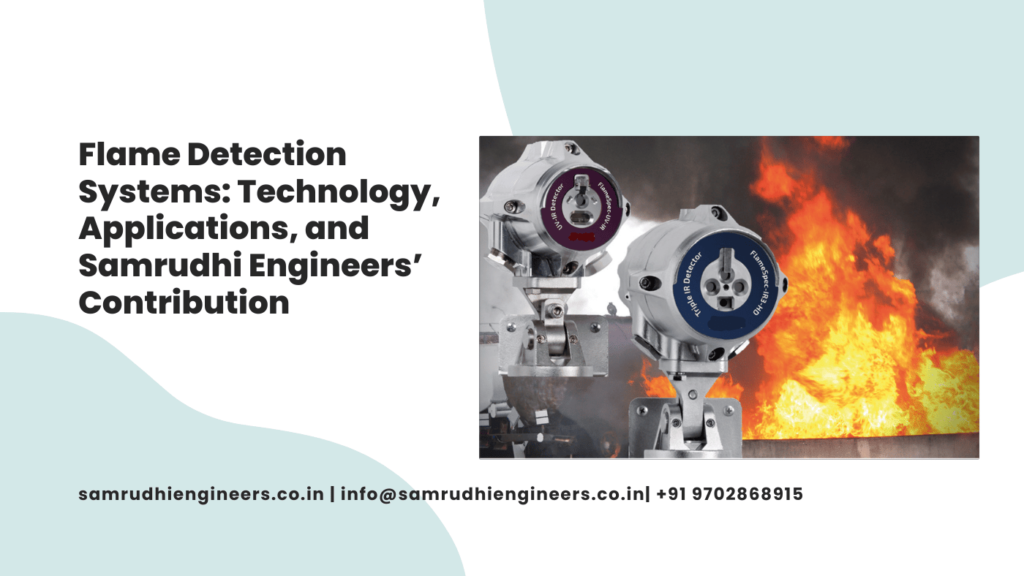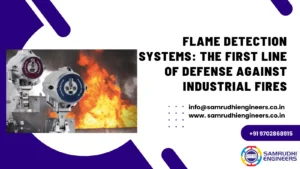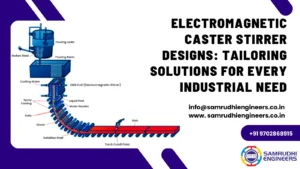Summary
Flame detection plays a vital role in ensuring industrial fire safety by identifying fires at their earliest stage—often before smoke or heat is noticeable. This blog by Samrudhi Engineers explains how different flame detection technologies, such as UV, IR, and multi-spectrum detectors, work to deliver rapid and reliable fire alerts. It highlights their applications across industries like oil & gas, manufacturing, power generation, and chemical plants, while emphasizing proper installation, maintenance, and integration for maximum effectiveness. With expert system design, compliance with safety standards, and dedicated aftercare services, Samrudhi Engineers helps industries build robust flame detection systems that safeguard people, property, and productivity.
Fires start fast and silently. In industrial environments — refineries, chemical plants, warehouses, power stations, and manufacturing units — an unchecked flame can mean catastrophic damage, production loss, environmental hazard, and risk to human life. Flame detection is the frontline of active fire protection: it spots the presence of flames quickly, reliably, and often before smoke or heat detectors respond. For businesses that prioritise safety and continuity, investing in the right flame detection system is non-negotiable. In this post, Samrudhi Engineers explains how flame detection works, the types of detectors available, where they’re used, best practices for selection and maintenance, and why an expert partner matters.
Why flame detection matters
Traditional smoke detectors and heat sensors are excellent for many applications, but they have limitations. Smoke-based detection can be delayed in open spaces or where combustion is clean; heat detectors require a temperature rise that may arrive too late. Flame detectors, by contrast, are designed to sense characteristics unique to flames — light in specific spectral bands or rapid flicker — and so can detect fires almost instantly. This speed can make all the difference when hazardous materials, high-value assets, or large numbers of people are involved.

Key benefits:
Faster detection: Recognises flames seconds earlier than many smoke/heat systems.
Reduced false alarms: Modern detectors use multiple spectral bands and intelligent algorithms to distinguish real flames from sunlight, welding, or hot surfaces.
Wide coverage: Certain detectors can monitor large areas where traditional detectors struggle.
Integration-friendly: Works alongside fire alarm, suppression, and safety management systems.
How flame detectors work — the principles
Flame detectors sense light or flicker signatures that are typical of combustion. The main sensing technologies are:
Ultraviolet (UV) detectors: Sense UV radiation emitted by flames. They respond quickly but can be susceptible to false alarms from arc welding or certain UV sources. UV detectors are often used where visibility is obstructed or as part of combined systems.
Infrared (IR) detectors: Flames emit strongly in the infrared range. Single-band IR detectors are fast and simple but can be triggered by hot surfaces or sunlight reflections.
Multi-spectrum IR (IR3 or dual/tri-spectrum) detectors: Compare signals across several IR bands to reliably identify flame signatures and reject spurious sources. These are widely used in industrial settings for their balance of speed and immunity to false positives.
UV/IR combined detectors: Use both UV and IR sensors together to improve reliability — both a UV and IR signature must be present for alarm, which reduces false alarms from welding or sunlight.
Imaging and video-based detectors: Use cameras (IR, visible, or multispectral) and image-processing algorithms to detect flames and their position. These systems can locate a fire, track its development, and even feed visuals into control rooms.
Line-scanning and scanning IR systems: For long corridors, tunnels, or large open areas, scanning detectors sweep across a field of view and detect flames at distance.
Each technology has trade-offs in sensitivity, immunity to interference, detection range, and cost. The right choice depends on hazards, environment, sight-lines, and whether precise location reporting is needed.
Types of flame detectors and where to use them
Point flame detectors: Monitor a cone-shaped field of view from a fixed location. Ideal for monitoring tanks, pump skids, or specific equipment.
Imaging flame detectors (camera-based): Provide situational awareness and location data; excellent for large yards, LNG terminals, and critical outdoor assets.
Line-of-sight/beam detectors: Common in tunnels and long halls where you need to monitor a linear space.
Portable/handheld detectors: Used for inspections and temporary monitoring during maintenance or testing.
Flame detector networks: Multiple detectors connected to a control system for redundancy and comprehensive coverage in complex facilities.
Applications: industries that benefit most
Oil & Gas and Petrochemical: Hydrocarbon fires are fast and intense; flame detectors are essential for early warning on platforms, refineries, and tank farms.
Power generation: Turbines, transformers, and fuel handling areas benefit from fast flame sensing.
Chemical and process plants: Detecting small flames before they escalate can prevent chain-reaction incidents.
Warehouses and manufacturing: Where large open floor areas reduce the effectiveness of smoke detectors.
Aviation and hangars: Rapid detection reduces risk to aircraft and infrastructure.
Commercial kitchens and cooking lines: Specialised detectors can detect open-flame cooking incidents while reducing false alarms from steam or hot surfaces.
Transportation tunnels and metros: Robust, fast detectors protect enclosed spaces where smoke can spread quickly.
Standards, siting, and integration — getting it right
Effective flame detection is not just about picking the most advanced sensor — proper design, positioning, and integration determine real-world performance.
Standards and compliance
Flame detection systems should conform to industry standards and local regulations. Depending on region and application, standards from bodies such as NFPA, EN, IEC, and local authorities provide guidance for detector types, performance, and acceptance testing. Compliance ensures that detection performance meets documented requirements and that systems integrate safely with alarm, shutdown, and suppression controls.
Risk assessment and detector siting
A structured hazard and risk assessment identifies what needs protection, likely fire scenarios, and the optimum detector types and placement. Considerations include:
Line-of-sight to potential flame sources (obstructions cause blind spots).
Environmental conditions: rain, fog, dust, sunlight angles, reflective surfaces.
False alarm sources: welding, hot equipment, vehicle headlights.
Required detection range and response time.
Redundancy for critical zones — overlapping fields of view reduce single-point failures.
Minimising false alarms — practical tips
False alarms are costly and dangerous (they can lead to complacency). To reduce them:
Use multi-spectrum IR or combined UV/IR detectors where sunlight or hot surfaces are present.
Apply masking or sun-shields on detectors where glare is an issue.
Use intelligent algorithms and configurable sensitivity levels tailored to the environment.
Implement layered detection strategies — imaging detectors plus point sensors — so that multiple cues confirm a real flame.
Plan maintenance and routine calibration to avoid drift and degradation that cause spurious alarms.
Installation, testing and maintenance
A detector is only as good as its upkeep. Best practices include:
Professional installation: Proper alignment, secure mounting, and correct cabling are essential.
Commissioning tests: Field tests with approved test methods validate sensitivity and response time. Log all test results for compliance.
Routine inspection and cleaning: Dust, salt, and airborne contaminants can reduce detector sensitivity — particularly for optical systems. Clean lenses and housings on a schedule based on site conditions.
Calibration and functional testing: Periodic checks ensure detectors meet their original performance specifications. Replace or recalibrate per manufacturer guidance.
Spare parts and redundancy planning: Keep critical spares and plan for detector replacement windows to avoid coverage gaps.
Samrudhi Engineers provides full lifecycle support — from design and commissioning to scheduled maintenance and emergency service — ensuring systems keep performing when it matters most.
Choosing the right flame detection solution — a step-by-step guide
Perform a detailed hazard analysis: Identify fuels, likely ignition sources, process conditions, and consequences.
Select detector technology: Match detector type (UV, IR, IR3, imaging) to the environment and false alarm profile.
Design coverage and layout: Avoid blind spots, ensure overlap where needed, and account for obstructions.
Integrate with controls: Define alarm thresholds, suppression interlocks, and notification paths.
Test and commission: Use approved methods and document performance.
Train operators and maintenance teams: Clear procedures for alarm response, detector testing, and routine care.
Review and upgrade: As operations change, revisit detection strategy to maintain effectiveness.
Why partner with Samrudhi Engineers?
Flame detection systems are technical and safety-critical. Samrudhi Engineers brings deep experience in fire detection and suppression for industrial clients across India. Our strengths:
Tailored solutions: We design systems to meet specific industrial risks and operational constraints.
End-to-end delivery: From risk assessment and design to installation, commissioning, and maintenance.
Compliance-first approach: Systems designed to meet applicable standards and site regulations.
Experienced technicians: Field teams trained in safe installation and testing, minimising downtime.
Real-world impact — prevention, protection, peace of mind
Early flame detection saves assets and lives. A correctly specified and maintained flame detection system reduces the risk of large-scale fire development, enables faster intervention by safety teams, and minimises downtime. For industries handling flammable liquids, gases, or high-temperature processes, the difference between early flame detection and delayed alarm can be measured in irreversible damage — to property, the environment, and human life.
Conclusion
Flame detection is a critical part of modern fire safety strategies — especially in high-risk and industrial environments. Selecting the right detector technology, placing devices thoughtfully, integrating alarms with suppression and control systems, and maintaining equipment on schedule are all essential to achieving reliable protection.
If you’re evaluating flame detection for a facility, considering an upgrade, or want a professional risk assessment, Samrudhi Engineers can help. We combine technical expertise, project delivery experience, and responsive aftercare to build flame detection systems that protect what matters most.
Ready to protect your facility with proven flame detection solutions? Contact Samrudhi Engineers for a site assessment and customised proposal — because when it comes to fire safety, early detection is everything.







